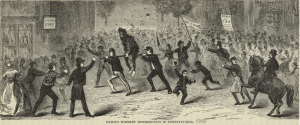Both the inhabitants of western Pennsylvania and the federal government needed alcohol, but each for a different reason. The farmers in western Pennsylvania distilled their grain into alcohol so that it could be easily transported to the east coast and sold. The purpose of the Whiskey Act of 1791 was to tax the spirits produced by distillation in order to fund the repayment of debts associated with the Revolutionary War. The distillers found it difficult to pay the duties on distilled spirits and turn a profit from their efforts. They also saw the collection of taxes as an extremely powerful and constrictive federal act. Office holders within the federal government such as President Washington believed the execution of the law to be unquestionable as the authority to collect taxes was specifically grated by the U.S. Constitution.1
The argument over paying the tax and the federal government’s authority to impose such a measure is the base upon which the rebellion was built. Meetings including citizens from the Pennsylvanian counties of Washington, Westmoreland, Allegheny, and Fayette enacted motions to withhold support and refuse communication with all federal collection officers. The inhabitants of the western counties passed these resolutions in August and September of 1791.2 Unfortunately, public gatherings protesting the excise and the unfavorable attitude toward tax collectors were among the least severe acts of protest. Several men were attacked, tarred, and feathered due to their role or perceived role in the collection of the spirit excise. One of which was Robert Johnson, the Revenue Collector for Alleghany and Washington Counties. In August of 1792, an army captain by the name of Faulkner was threatened at knife point for allowing his home to be used as an office for the Inspector of Revenue, General John Neville. A summary of these acts of opposition as well as a relatively complete account of the entire opposition can be found in a letter from Hamilton to Washington dated August 5th, 1794.3
The hostility escalated early on and called the role of the federal government into question. The inhabitants of western Pennsylvania resorted to threats and acts of violence as a means to emphasize their perspective. As a result, their opposition was labeled an insurgency. As with any insurgency, the people and function of the government were at stake, however, the nation’s newly acquired independence intensified the danger. The leaders of the United States had no precedent to use for modeling a response to a threatening insurgency. With the country at stake, the federal government was forced to counter.
- Christine Sternberg Patrick, ed., The Papers of George Washington Presidential Series. Vol. 11 (Charlottesville and London: University of Virginia Press, 2002.), 122. ↩
- John B. Linn and WM Hegle, ed., Pennsylvania Archives Second Series Vol. IV (Harrisburg: J. Severns & Company, 1876), 20-22, accessed November 28, 2013, https://play.google.com/books/reader?id=CXIFAAAAQAAJ&printsec=frontcover&output=reader&authuser=0&hl=en&pg=GBS.PA20. ↩
- Harold C. Syrett, ed., The Papers of Alexander Hamilton, Vol. XVII (New York and London: Columbia University Press, 1967), 24-58. ↩
